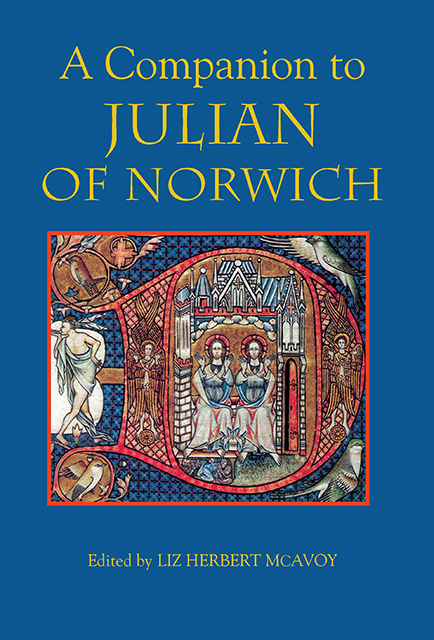2 - ‘A Recluse Atte Norwyche’: Images of Medieval Norwich and Julian's Revelations
Published online by Cambridge University Press: 10 March 2023
Summary
We know nothing conclusive about Julian's early life, but she indicates that she had been devout since her youth; if Julian's childhood and youth had been spent in Norwich, how would the experiences of her early life have fed her devotional life and possibly informed her visions? Among the evidence that Norman Tanner cites in support of his claim that Norwich may have been ‘Europe's most religious city’ is the number of hermits and anchorites supported by the city in the high Middle Ages. Pre-eminent among these anchorites is Julian herself, the ‘star attraction’ of the spiritual life of Norwich. But it is possible to look at the situation another way: while Julian may be proof of the religiosity of Norwich, could it be that the religious atmosphere, devotional practices and imagery of Norwich made Julian's spirituality possible and inspired her writing? The very buildings manifested both the economic importance and religious significance of the city: the magnificent Norman Cathedral challenged the dominance of the Castle; the splendid church of St Peter Mancroft overshadowed the marketplace. Every day in the city was punctuated by the ringing of bells of nearly sixty churches, and the chanting and singing in religious houses provided a counterpoint to the noise and bustle of the marketplace. The impact of religion was auditory, olfactory and, above all, visual.
Every ‘major European development in the practice of institutional religion’ from the Benedictine monastic cathedral to the ‘Great Hospital’ of St Giles and the secular college of St Mary in the Fields was represented in Norwich; the most important new movement in the high Middle Ages was that of the mendicant friars, all four major orders of which had houses in Norwich. Both Dominicans and Franciscans were dedicated to preaching to the people and used techniques such as colourful narrative stories or exempla to attract lay audiences; sermons were an important way of educating and inspiring people both religious and lay. One of the few pieces of information Julian gives about her early life is that she heard ‘a man telle of halye kyrke of the storye of Sainte Cecille’ (Vision, 1.36), presumably in a sermon. Julian may have been a nun at Carrow Priory, whose large church was used for preaching by resident and visiting clergy.
- Type
- Chapter
- Information
- A Companion to Julian of Norwich , pp. 32 - 41Publisher: Boydell & BrewerPrint publication year: 2008
- 3
- Cited by



